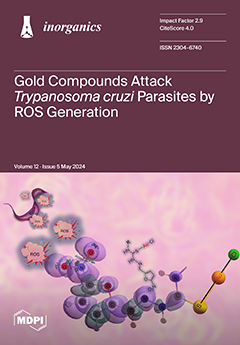Three new heteroleptic Ag(I) complexes, labeled as [AgL(POP)]BF
4 (
1–
3), were successfully synthesized and comprehensively characterized. Here, L represents 2,9-bis((E)-4-methoxystyryl)-1,10-phenanthroline (
L1), 2,9-bis((E)-4-methylthiostyryl) -1,10-phenanthroline (
L2), and 2,9-bis((E)-4-diethylaminostyryl)-1,10-phenanthroline (
L3), while POP stands for Bis[(2-diphenylphosphino)phenyl] ether.
[...] Read more.
Three new heteroleptic Ag(I) complexes, labeled as [AgL(POP)]BF
4 (
1–
3), were successfully synthesized and comprehensively characterized. Here, L represents 2,9-bis((E)-4-methoxystyryl)-1,10-phenanthroline (
L1), 2,9-bis((E)-4-methylthiostyryl) -1,10-phenanthroline (
L2), and 2,9-bis((E)-4-diethylaminostyryl)-1,10-phenanthroline (
L3), while POP stands for Bis[(2-diphenylphosphino)phenyl] ether. The stability of these compounds in solution was confirmed through multinuclear 1D (
1H,
13C,
31P) and 2D NMR (COSY, NOESY, HMBC, HSQC) spectroscopies. Additionally, their molecular structure was elucidated via X-ray crystallography. The photophysical properties of the complexes were assessed both in the solid state and in solution (dichloromethane). Compounds
1–
3 demonstrated moderate emissions in solution, with quantum yields ranging from 11–23%. Interestingly, their solid-state luminescent behavior differed. Large bathochromic shifts (42–75 nm) of the emission maxima and a decrease in quantum yields (2.5–9.5%) were evident, possibly due to the presence of excimers. Compound
3 stands out as a rare example of an Ag(I) red-color emitter.
Full article





